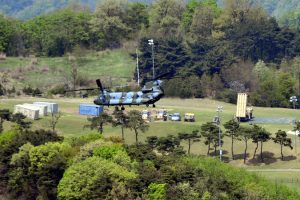
Moon: Offer outstretched hand hoping to reduce potential nuclear tensions w promise of economic integration. Trump: Apply maximum pressure — financial cutoffs, deployment of new missile defenses & warships off North’s coast, accelerated digital sabotage of its missile program — before turning to engagement — an approach allegedly drawn from his real-estate experience: Inflict maximum pain first, then see if other guy wants to talk. Trump helped bring about Moon’s victory in South Korea’s election with ill-timed insistence South would have to pay for the cost of installing US-built THAAD antimissile system, which Moon opposes. That fueled sense in South Korea that country was again being pushed around by its longtime protector, whom it relies on for defense — but often resents. Top: Moon’s supporters “give peace a chance”. Bottom: US THAAD anti-missile installation.
President Trump finds himself on a collision course with new South Korean President Moon Jae-In, who has hinted at a revival of the “Sunshine” approach,
one that is in direct contradiction to the path Trump has set to fulfill his vow to “solve” the North Korean nuclear problem, one way or another.
Trump “Approach” – Pressure First, Then Perhaps Negotiate
Trump’s strategy is to apply maximum pressure on North Korea’s leader, Kim Jong-un —
- financial cutoffs,
- the deployment of new missile defenses and warships off the North Korean coast, and
- accelerated digital sabotage of its missile program —
before turning to engagement.
It is an approach allegedly drawn from Trump’s real-estate experience:
Inflict maximum pain first, then see if the other guy wants to talk.
Secretary of State Rex W. Tillerson described the strategy to State Department officials last week as “a pressure campaign that has a knob on it,”
adding, “I’d say we’re at about dial setting 5 or 6 right now.”
He described the next step as pressuring nations around the world
“to fully implement the UN Security Council resolutions regarding sanctions, because no one has ever fully implemented those.”
Moon Strategy — Offer Help In Hopes Of Avoiding Nuclear Catastrophe
Moon’s strategy is the opposite:
to offer an outstretched hand to the North Koreans first,
in the hope of reducing tensions with the promise of economic integration.
Just because that effort failed the last time it was tried in the early years of this century,
he argued during a hard-fought campaign, does not mean it will fail again,
as he deals with an erratic, 33-year-old leader in Pyongyang whose main interest is remaining in power.
At first glance, these are “completely divergent views on how to deal with Pyongyang,”
Duyeon Kim, a longtime North Korea scholar, wrote in Foreign Affairs on Monday.
Trump, she argued, helped bring about Moon’s victory in South Korea’s election with his ill-timed insistence last week
that South Korea would have to pay for the cost of installing a new American-built antimissile system, called Terminal High Altitude Area Defense, or THAAD,
about which Moon has expressed deep reservations.
That only fueled the sense in South Korea that the country was again being pushed around by its longtime protector,
whom it relies upon for defense but often resents.
What the South Korean public feared, Ms. Kim wrote, was that Trump’s reliance on pressure and the vague threat of military action
was leading the alliance to a cycle of miscalculation and escalation that could result in resumption of a war that was halted — with no peace treaty — in 1953.
China Likes Moon’s New Approach Much Better
With Moon’s election, South Korea and China are now fundamentally on the same page about how to deal with the North:
Do what it takes to maintain the status quo and avoid any situation
that could result in hostilities that would throw East Asia into chaos,
and perhaps set off a financial panic.
The Chinese, while promising some tougher sanctions against the North, hope to freeze the North Korean nuclear and missile arsenals where they are,
and channel Trump into a new set of negotiations that would probably take years.
Incoherence of Trump / Tillerson – TNT — “Strategy”
So far, Tillerson and Trump have been all over the map about what they would require to open those talks.
On a visit to Seoul during its presidential campaign,
Tillerson insisted the North would first have to give up its entire arsenal before talks began —
even though dismantling that arsenal is the ultimate goal of those negotiations.
He modified that view at the UN, suggesting talks were possible
once the North began moving toward disarmament — though he did not say how far.
Then Trump said he would be “honored” to meet Kim, under the right conditions, which he also did not define.
If this was meant to confuse allies and adversaries alike, it worked.
No one seems clear what the administration’s conditions for talks are,
and White House officials say they do not want to be too specific.
Moon Used To Being “Good Cop” To US’ “Bad Cop”
Moon, meanwhile, has long experience playing good cop to Washington’s bad cop.
He was chief of staff to Roh Moo-hyun, his political mentor,
whose approach to the North was viewed in Washington as just this side of capitulation.
In fact, the move to lift the pressure on Banco Delta Asia, a small bank in Macau,
where Kim Jong-il, father of the current North Korean leader, kept the assets used to pay off the North Korean elite,
came just months after the North’s first nuclear test, in 2006.
And it occurred about the same time North Korea was secretly helping the Syrians build a nuclear reactor,
which the Israelis later destroyed in a surprise air attack.
During the campaign, Moon said sanctions had one goal:
to bring the North Koreans back to the negotiating table.
The Trump administration has said they have a different goal:
to force the North to give up its entire arsenal.
That is a significant difference.
Moon has many reasons to seek de-escalation, and his victory on Tuesday proved that his view is, for now, popular in the South.
He fundamentally believes that the “Sunshine Policy” is the only option to avert a renewed conflict.
But he also wants to end a Chinese-led boycott of some South Korean goods that was set off by the installation of the THAAD system,
which Beijing says is aimed at countering its own nuclear arsenal.
So far, Moon has been careful not to threaten to dismantle the system —
which the Pentagon rushed into preliminary operation last week in a blatant move to pre-empt the likely results of the election —
until he completes a review of the issue.
He appears to be leaving himself some flexibility.
Trump has a little time to try to bridge this divide, but not much —
Moon was sworn in Wednesday
Source: Trump on Collision Course With South Korean Leader on Dealing With North – The New York Times
